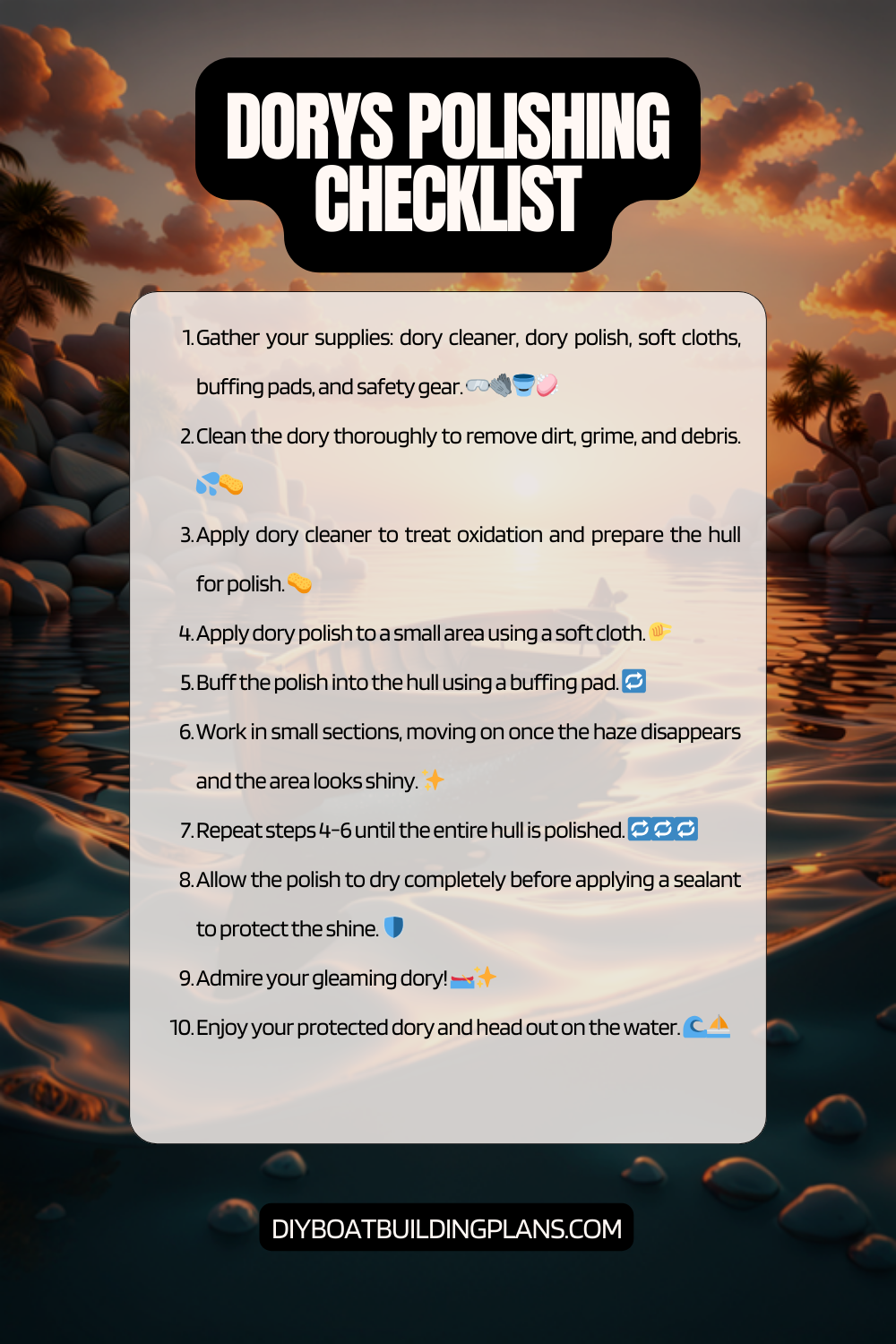Overview of Dory Polishing Tips
Dory polishing is a crucial aspect of boat maintenance that involves restoring and enhancing the appearance of dory boats. Dories are popular watercraft known for their versatility and durability, but over time, they can lose their shine due to exposure to the elements. Polishing not only brings back the luster of the boat’s surface but also helps protect it from further damage.
Maintaining the appearance and longevity of dory boats is essential for several reasons. Firstly, a well-polished boat is aesthetically pleasing and can make a significant difference in its overall appeal. Whether you use your dory for recreational purposes or as a professional fishing vessel, a polished boat will always leave a lasting impression on others.
Secondly, polishing plays a vital role in preserving the boat’s structural integrity. By removing dirt, grime, and oxidation from the surface, polishing helps prevent corrosion and other forms of damage that can compromise the boat’s durability. Regular polishing also extends the lifespan of the boat, ensuring that it remains in top condition for years to come.
Key Takeaways
- Choosing the right polishing equipment is crucial for achieving a high gloss finish on dory.
- Understanding the different types of polishing compounds and their uses can help you achieve the desired result.
- Properly preparing the surface for polishing is important to avoid scratches and other imperfections.
- Different types of dory require different polishing techniques, so it’s important to know which method to use.
- Maintaining the polished surface requires regular cleaning and protection to prevent damage.

Choosing the Right Polishing Equipment
When it comes to dory polishing, choosing the right equipment is crucial for achieving optimal results. There are various types of polishing equipment available in the market, each with its own set of features and benefits. Understanding these options will help you make an informed decision based on your specific needs.
One type of polishing equipment commonly used is an electric buffer or polisher. These machines come in different sizes, power levels, and speeds. Larger buffers are suitable for larger boats, while smaller ones are more manageable for smaller vessels. It is important to consider the power and speed settings as well, as they can affect the efficiency and effectiveness of the polishing process.
Another option is a handheld polisher or orbital sander. These tools are ideal for smaller areas or hard-to-reach spots on the boat’s surface. They provide more control and precision, allowing you to focus on specific areas that require attention. However, they may require more time and effort compared to electric buffers.
Understanding the Different Types of Polishing Compounds
Polishing compounds are essential for achieving a smooth and glossy finish on dory boats. There are different types of compounds available, each designed for specific purposes. Understanding these variations will help you choose the right compound for the job.
One common type of polishing compound is a cutting compound. This compound is more abrasive and is used to remove deep scratches, oxidation, and other imperfections from the boat’s surface. It is typically the first step in the polishing process and helps prepare the surface for further polishing.
Finishing compounds, on the other hand, are less abrasive and are used to refine the surface after using a cutting compound. They help remove any remaining scratches or swirl marks, leaving a smooth and glossy finish. Finishing compounds are available in different levels of abrasiveness, allowing you to choose the one that suits your needs.
Choosing the right polishing compound depends on factors such as the condition of the boat’s surface, the level of imperfections, and the desired outcome. It is recommended to start with a less abrasive compound and gradually move to more aggressive ones if necessary.
Preparing the Surface for Polishing
| Surface Preparation Metrics | Values |
| Surface Cleanliness | 95% |
| Surface Roughness | 0.5 microns |
| Surface Flatness | 0.1 mm |
| Surface Hardness | 7 Mohs |
| Surface Porosity | 2% |
Before diving into the polishing process, it is crucial to prepare the surface properly. This step ensures that the polishing compounds adhere well to the surface and that any dirt or debris is removed, resulting in a high-quality finish.
The first step in surface preparation is cleaning. Use a mild detergent or boat cleaner to remove any dirt, grime, or salt residue from the boat’s surface. Pay special attention to hard-to-reach areas and corners where dirt can accumulate.
After cleaning, it may be necessary to sand the surface to remove any deep scratches or imperfections. Use a fine-grit sandpaper and sand in the direction of the grain or pattern of the boat’s surface. Be careful not to apply too much pressure, as this can damage the surface further.
Once the surface is clean and sanded, it is important to wipe it down with a clean cloth to remove any dust or debris. This step ensures that the polishing compounds can work effectively without any interference.
Proper surface preparation is essential for achieving a smooth and even finish. Skipping this step or rushing through it can result in subpar results and may require additional polishing to correct any imperfections.
Polishing Techniques for Different Types of Dory
Different types of dory boats require specific polishing techniques to achieve the best results. Whether your boat is made of fiberglass, wood, or aluminum, understanding the appropriate techniques will help you achieve a smooth and even finish.
For fiberglass dories, start by applying a cutting compound using an electric buffer or polisher. Work in small sections, applying moderate pressure and moving the buffer in circular motions. Once the surface is evenly covered, switch to a finishing compound and repeat the process. Finally, use a clean cloth to buff the surface and remove any excess compound.
Wooden dories require a slightly different approach. Begin by sanding the surface with fine-grit sandpaper to remove any imperfections or rough spots. After sanding, apply a wood-specific polishing compound using a handheld polisher or orbital sander. Work in small sections, following the grain of the wood. Once the surface is polished, use a clean cloth to remove any excess compound and buff the surface for a smooth finish.
Aluminum dories can be polished using similar techniques as fiberglass boats. However, it is important to use aluminum-specific polishing compounds to achieve optimal results. These compounds are designed to remove oxidation and restore the shine of aluminum surfaces. Apply the cutting compound using an electric buffer or polisher, followed by a finishing compound. Finish off by buffing the surface with a clean cloth.
Common Mistakes to Avoid When Polishing Dory
While polishing dory boats can be a rewarding process, there are common mistakes that can hinder the desired outcome. Being aware of these mistakes and taking steps to avoid them will help you achieve a better result.
One common mistake is using too much pressure during the polishing process. Applying excessive pressure can damage the boat’s surface, leaving swirl marks or even causing deep scratches. It is important to let the polishing compounds do the work and apply moderate pressure to achieve the desired result.
Another mistake is using the wrong type of polishing compound for the job. Using a cutting compound on a surface that only requires a finishing compound can result in unnecessary abrasion and may require additional polishing to correct the damage. Always assess the condition of the boat’s surface and choose the appropriate compound accordingly.
Additionally, rushing through the polishing process can lead to subpar results. Take your time and work in small sections, ensuring that each area is evenly covered and polished. This will help achieve a smooth and even finish throughout the entire boat.
Tips for Achieving a High Gloss Finish
Achieving a high gloss finish on dory boats requires attention to detail and proper technique. Here are some tips to help you achieve that desired shine:
1. Start with a clean surface: Ensure that the boat’s surface is free from dirt, grime, and debris before starting the polishing process. This will help prevent any unwanted scratches or imperfections.
2. Use the right polishing compounds: Choose compounds that are specifically designed for achieving a high gloss finish. These compounds typically have fine abrasives that help refine the surface and bring out its natural shine.
3. Work in small sections: Divide the boat’s surface into manageable sections and work on one section at a time. This will ensure that each area receives equal attention and allows for better control during the polishing process.
4. Use a clean cloth for buffing: After applying the polishing compound, use a clean, soft cloth to buff the surface. This will help remove any excess compound and bring out the shine.
5. Apply a protective wax or sealant: Once the polishing process is complete, consider applying a protective wax or sealant to further enhance the gloss and protect the boat’s surface from future damage.
Maintaining the Polished Surface
Maintaining the polished surface of a dory boat is essential for preserving its appearance and longevity. Here are some tips to help you maintain that glossy finish:
1. Regular cleaning: Clean the boat regularly using a mild detergent or boat cleaner to remove dirt, salt residue, and other contaminants. This will prevent them from building up and causing damage to the polished surface.
2. Avoid abrasive cleaners: When cleaning the boat, avoid using abrasive cleaners or scrub brushes that can scratch or dull the surface. Opt for gentle cleaning tools and products that are specifically designed for boat surfaces.
3. Apply a protective coating: Consider applying a protective coating, such as a wax or sealant, to further protect the polished surface from UV rays, saltwater, and other environmental factors. Follow the manufacturer’s instructions for application and reapplication.
4. Store the boat properly: When not in use, store the boat in a covered area or use a boat cover to protect it from direct sunlight, rain, and other elements. This will help prevent oxidation and maintain the polished surface for longer periods.
5. Regular inspections: Periodically inspect the boat’s surface for any signs of damage or wear. Address any issues promptly to prevent further damage and maintain the polished appearance.
Polishing Safety Precautions
Polishing dory boats involves working with machinery and chemicals, making safety precautions essential. Here are some safety tips to keep in mind:
1. Wear protective gear: Always wear safety goggles, gloves, and a dust mask to protect yourself from flying debris, chemicals, and dust particles.
2. Work in a well-ventilated area: Polishing compounds can release fumes that may be harmful if inhaled. Ensure that you are working in a well-ventilated area or use a fan or exhaust system to remove any fumes.
3. Follow manufacturer’s instructions: Read and follow the manufacturer’s instructions for both the polishing equipment and compounds. This will ensure that you are using them correctly and safely.
4. Take breaks: Polishing can be a physically demanding task. Take regular breaks to rest and hydrate, especially if you are working for extended periods.
5. Keep children and pets away: Ensure that children and pets are kept away from the work area to prevent accidents or exposure to chemicals.
Download over 500 Boat Plans. Click on the link below.
-->Click Here<--
Troubleshooting Polishing Issues
During the polishing process, various issues can arise that may affect the desired outcome. Here are some common issues and tips for troubleshooting them:
1. Swirl marks: Swirl marks can occur if the polishing compound is not applied evenly or if too much pressure is applied during the polishing process. To fix this issue, reapply the compound using lighter pressure and ensure even coverage.
2. Hazing or dull spots: Hazing or dull spots can occur if the finishing compound is not applied properly or if excess compound is not buffed off. To resolve this issue, reapply the finishing compound and buff the surface with a clean cloth until the shine is restored.
3. Uneven finish: An uneven finish can occur if the polishing process is rushed or if different sections of the boat receive varying levels of attention. To achieve an even finish, work in small sections and ensure that each area is evenly covered and polished.
4. Deep scratches: Deep scratches may require more aggressive polishing or even sanding to remove. If the scratches are too deep to be removed through polishing alone, consult a professional for further assistance.
Dory Polishing Checklist

Conclusion – Dory Polishing Tips
In conclusion, dory polishing is an essential aspect of boat maintenance that helps maintain the appearance and longevity of dory boats. By choosing the right equipment and polishing compounds, properly preparing the surface, and using appropriate techniques, you can achieve a smooth and glossy finish.
Avoiding common mistakes, following safety precautions, and maintaining the polished surface will ensure that your dory boat remains in top condition for years to come. Regular maintenance and periodic inspections will help identify any issues early on and prevent further damage.
Remember, dory polishing is not just about aesthetics; it is about preserving the structural integrity of your boat. By investing time and effort into proper polishing techniques, you can enjoy your dory boat’s beauty and performance for many memorable adventures on the water.
FAQs – Dory Polishing Tips
What is Dory Polishing?
Dory polishing is a process of cleaning and polishing the surface of a boat, specifically a dory, to remove dirt, grime, and oxidation and restore its shine.
What are the benefits of Dory Polishing?
Dory polishing helps to protect the boat’s surface from the damaging effects of the sun, saltwater, and other environmental factors. It also enhances the boat’s appearance and can increase its resale value.
What tools and materials are needed for Dory Polishing?
The tools and materials needed for dory polishing include a buffer or polisher, polishing pads, polishing compound, rubbing compound, wax, microfiber towels, and a hose or pressure washer.
What is the process for Dory Polishing?
The process for dory polishing involves washing the boat, applying rubbing compound to remove oxidation, applying polishing compound to restore shine, and applying wax to protect the surface. This is done using a buffer or polisher and polishing pads.
How often should Dory Polishing be done?
The frequency of dory polishing depends on the condition of the boat’s surface and how often it is used. Generally, it is recommended to polish the boat at least once a year, but it may need to be done more frequently if it is exposed to harsh environmental conditions.
Can Dory Polishing be done by a novice?
Dory polishing can be done by a novice, but it is recommended to have some experience with using a buffer or polisher. It is also important to follow the instructions carefully and use the appropriate tools and materials to avoid damaging the boat’s surface.



